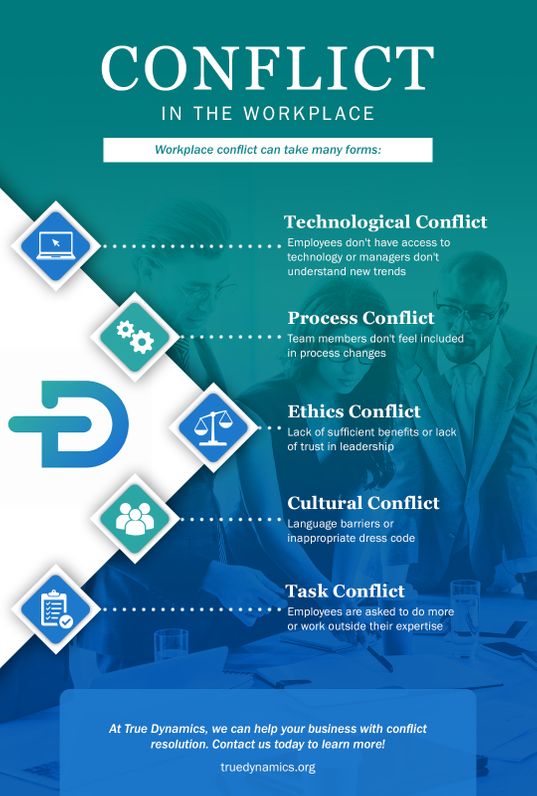Conflict in the Workplace
Organizational Conflict
As organizations grow, friction and tension will inevitably arise when different points of view collide, which in turn can lead to conflict at work. The best way to handle this situation is through mediation. A neutral third party helps the individuals involved reach an agreement or compromise beneficial to both parties with minimal disruptions within the organization. This approach increases employee satisfaction and creates high-performing teams by building trust.

Areas of Conflict in the Workplace

Technological Conflict
Employees do not have access to the necessary technology they need to perform their jobs successfully
Managers who do not understand or know how to use new technologies implemented throughout an organization can lead staff members to feel like they don't have support from supervisors leading them to disengage with work responsibilities
Monitoring devices (iPads, laptops) take up too much space within cubicle environments where employees become distracted when working nearby
Email overload

Process Conflict
Team members feel as though they are not being included in critical decision-making discussions among leadership teams or managers
Decision-making surrounding technology changes within an organization includes employees unfamiliar with certain software, hardware, etc., making them feel uncomfortable and disengaged
Leadership has one-way communication styles where staff members do not receive much information about what is happening next, leaving them feeling confused, frustrated, helpless after not feeling heard or included in the conversation.

Ethics Conflict
Companies that refuse to provide their employees with sufficient health care benefits leave them feeling unappreciated and undervalued
A company is implementing new changes within an organization during a time of high unemployment rates, where individuals feel as though they are being replaced by other workers who may be willing to accept lower salaries or compensation packages
Employees have difficulties trusting leadership teams/bosses due to a lack of transparency when making critical decisions that affect the individual professionally and the business holistically.

Cultural Conflict
Language barriers within the office where employees from different backgrounds have a difficult time communicating with one another
Inappropriate dress code being enforced among staff members may lead individuals to feel they can no longer be themselves at work, potentially impacting their job satisfaction
Conflicts can occur between individuals from different backgrounds (race, religion, ethnicity, etc.)

Task Conflict
Employees are constantly asked by managers/supervisors for additional help (e.g., working weekends) without offering compensation
Managers asking employees outside their scope of authority with little to know time to process or assess capabilities.
The number of hours worked versus amount paid back through vacation days etc
Competing priorities among teams within different departments (e.g., marketing vs. customer service)

Organizational Conflict
Issues among coworkers who feel as though they are not receiving enough support from their peers when working on projects.
Employees feel left out or rejected by other individuals within an organization because there is no sense of mutual respect,
Different departments fail to work together to accomplish common goals due to a lack of communication, transparency, effective leadership and so on.
